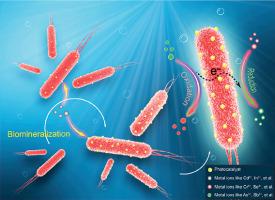Water Research ( IF 12.8 ) Pub Date : 2021-02-27 , DOI: 10.1016/j.watres.2021.116984 Wenlu Zuo , Yadong Yu , He Huang

|
Heavy metal contamination has received increasing attention as a growing worldwide environmental problem. Traditional remediation methods are mainly based on adsorption, precipitation and oxidation–reduction, which reduce the availability or toxicity of heavy metal ions. Microbe-photocatalyst hybrids (MPH), which behave as a semi-artificial photosynthetic system, integrate microbial cells with artificial photocatalysts for solar-to-chemical conversion. A few very recent studies indicate that MPH can be applied to treat organic contamination in water. Here, we propose a novel idea that MPH may also have great potential for solving heavy metal pollution. Heavy metals in wastewater could possibly be utilized to synthesize photocatalysts for MPH by microbial mineralization. Photo-induced electrons generated by photocatalysts in MPH can be transferred into microbial cells to promote intracellular enzymatic reductions, which allows heavy metal ions such as Cr6+ and Se4+ to be reduced and detoxified. Moreover, heavy metal ions like As3+ and Sb3+ can be used as sacrificial electron donors to maintain the continuous operation of the MPH, whereby these metal ions are simultaneously oxidized and detoxified. The excellent potential of MPH in the treatment of heavy metal-polluted wastewater is explained and a solution based on MPH is put forward as well as verified experimentally in this work. This solution can realize electron transfer between different metal ions to simultaneously remediate multiple heavy metal ions in wastewater. This finding may bring new hope for treating multiple heavy metal polluted wastewater in the future.
中文翻译:

掀起波澜:微生物与光催化剂的混合体可能为处理重金属污染的废水提供新的机会
随着世界范围内日益严重的环境问题,重金属污染受到越来越多的关注。传统的修复方法主要基于吸附,沉淀和氧化还原,这会降低重金属离子的利用率或毒性。微生物-光催化剂杂化体(MPH)充当半人工光合作用系统,将微生物细胞与人工光催化剂整合在一起以进行太阳能转化为化学物质。最近的一些研究表明,MPH可用于处理水中的有机污染物。在这里,我们提出了一个新颖的想法,即MPH在解决重金属污染方面也可能具有很大的潜力。废水中的重金属可能通过微生物矿化作用被用于合成MPH的光催化剂。6+和Se 4+被还原和排毒。此外,诸如As 3+和Sb 3+之类的重金属离子可以用作牺牲电子给体,以保持MPH的连续运行,从而这些金属离子同时被氧化和解毒。阐述了MPH在重金属污染废水处理中的巨大潜力,提出了一种基于MPH的解决方案,并在实验中进行了实验验证。该解决方案可以实现不同金属离子之间的电子转移,同时修复废水中的多种重金属离子。这一发现可能为将来处理多种重金属污染的废水带来新的希望。



























 京公网安备 11010802027423号
京公网安备 11010802027423号